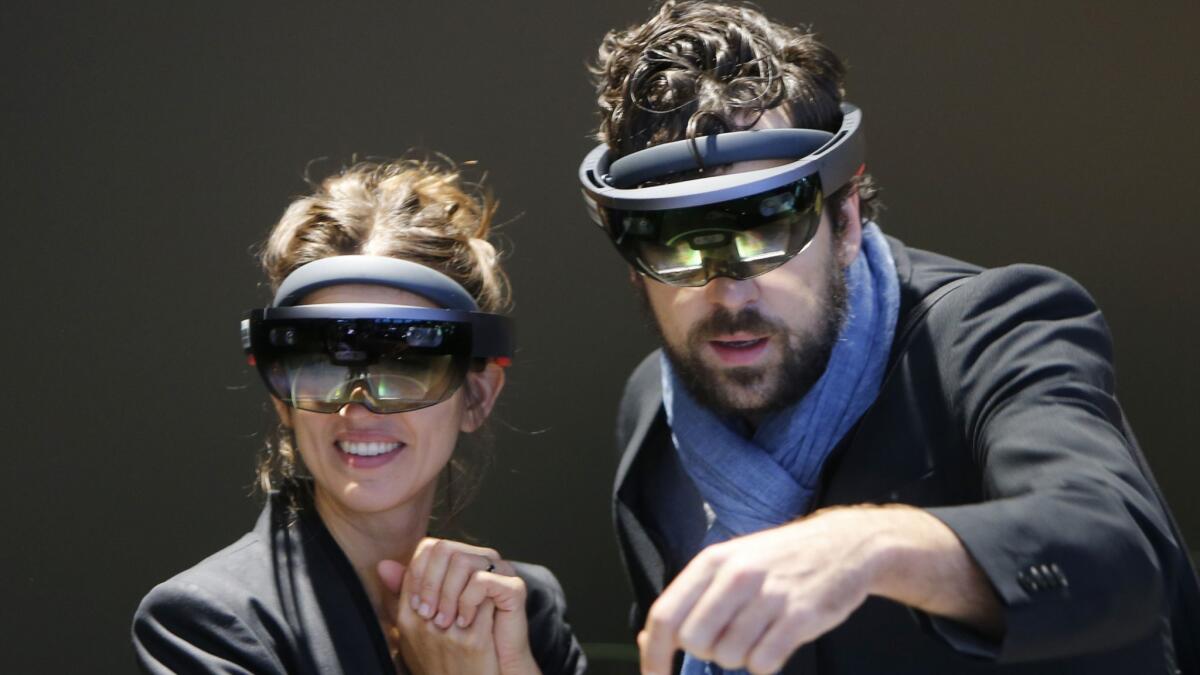Microsoft workers push against selling augmented-reality headsets to Army

- Share via
Employees at Microsoft Corp. demanded Friday that the company cancel a contract to supply its augmented-reality headsets to the U.S. Army, warning in a letter that putting HoloLens in the military’s hands could “help people kill.”
Writing to Chief Executive Satya Nadella, more than 50 workers said the devices would be “turning warfare into a simulated ‘video game.’” They also urged Microsoft, which won the $480-million contract in November, to “cease developing any and all weapons technologies” for the government.
“As employees and shareholders we do not want to become war profiteers,” the letter concluded. “To that end, we believe that Microsoft must stop in its activities to empower the U.S. Army’s ability to cause harm and violence.”
Representatives for Microsoft and the U.S. Army did not immediately respond to requests for comment. A Microsoft employee who helped draft the letter — speaking on the condition of anonymity out of concerns about retribution — shared a copy with the Washington Post and verified their identity.
The internal revolt at Microsoft highlights the heightened activism among employees at tech giants and follows similar uprisings at Amazon.com Inc. and at Alphabet Inc.’s Google, where workers have bristled over their companies’ business relationships with the U.S. military or law enforcement agencies. Google, for example, opted last year against renewing one of its own contracts with the Pentagon — a partnership to develop image-recognition tools for drones — because employees felt the tech giant shouldn’t be in the “business of war,” they said at the time.
Like its peers, Microsoft also has struggled to balance its relationship with the Department of Defense against its employees’ ethical and policy qualms about working with the U.S. government.
Last year, after workers petitioned the company to cancel a cloud-computing and artificial-intelligence contract with U.S. Immigration and Customs Enforcement, Microsoft said it would allow employees to change positions within the company if they found their existing roles betrayed their values. But Microsoft President Brad Smith has said the company would not cease working with the Department of Defense, a business relationship that he said dates back decades.
“As we have discussed these issues with governments, we’ve appreciated that no military in the world wants to wake up to discover that machines have started a war,” Smith wrote in an October blog post. “But we can’t expect these new developments to be addressed wisely if the people in the tech sector who know the most about technology withdraw from the conversation.”
Microsoft’s early marketing positioned the HoloLens as a “mixed reality” consumer device that architects, artists, video gamers and others could use to transpose computer graphics into real life. The holographic system is being sold to developers and businesses but is not yet available for public use. Microsoft is expected to unveil a new version of its HoloLens headset at a major industry trade show in Barcelona next week.
Last year, the headset proved to be the clincher for Microsoft to beat out two dozen other interested companies — including military contractors Lockheed Martin Corp. and Raytheon Co. and tech start-up Magic Leap — for the Army contract. The military said it could end up buying more than 100,000 of the systems in the coming years.
In August the Defense Department issued a request for an “integrated visual augmentation system” for training and combat that would give soldiers “increased lethality, mobility and situational awareness ... against our current and future adversaries,” military purchasing records show.
The military said it wanted a heads-up display system that could supercharge soldiers’ capabilities: giving them heat detection, night vision and the ability to view video and navigation; automatically recognizing and targeting “relevant threats”; and enabling them to stealthily see where their weapon was aiming, without using a laser that could give their location away.
The military also wanted the system to quickly identify landmines and improvised explosives and relay back real-time “squad lethality metrics” and health data, such as soldiers’ heart rate, breathing rate and whether they’ve sustained a concussion. The headset could also be used as part of an advanced simulation system that would “train units where they will fight [and] with whom they will fight,” contract documents show.






